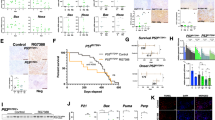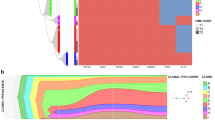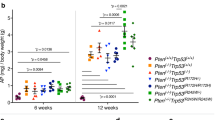Abstract
Erythroleukemias induced by Friend Murine Leukemia Virus (F-MuLV) involve the insertional activation of the proto-oncogene Fli-1, and the inactivation of the p53 tumor suppressor gene. While the activation of Fli-1 is an early, primary transforming event, p53 mutations are correlated with the immortalization of erythroleukemic cells in culture. In this study we have further analysed the role of p53 loss in F-MuLV induced erythroleukemias by examining the progression of this disease in p53 deficient mice. We found that p53−/− mice succumb to the disease more rapidly than p53+/+ littermates. Additionally, of the 112 tumors generated, 19 gave rise to immortal cell lines, eight of which were derived from p53−/− mice, and ten of which were from p53+/− mice. The ability of these primary tumor cells to grow in culture was associated with the complete loss of wild-type p53 in these cell lines. However, cells from many of the tumors induced in p53−/− hosts did not survive in vitro. These results suggest that the loss of p53 does not directly immortalize tumor cells. Instead, we have evidence to suggest that the loss of p53 promotes the accumulation of mutations that are required for survival in culture and that are capable of accelerating tumor progression in vivo. Indeed, mutations causing expression of the growth factor gene erythropoietin (Epo), were detected in two of seven Epo-independent cell lines from p53 deficient primary erythroleukemias. Moreover, the mechanism of activation of the Epo gene in one of these two Epo-independent cell lines involved genomic rearrangement, that is a hallmark of genetic instability. We propose that, in F-MuLV induced-erythroleukemias, p53 loss may encourage the accumulation of further mutations, subsequently conferring a growth advantage and immortality to the transformed erythroblasts.
This is a preview of subscription content, access via your institution
Access options
Subscribe to this journal
Receive 50 print issues and online access
$259.00 per year
only $5.18 per issue
Buy this article
- Purchase on SpringerLink
- Instant access to full article PDF
Prices may be subject to local taxes which are calculated during checkout






Similar content being viewed by others
References
Baker SJ, Preisinger AC, Jessup JM, Paraskeva C, Markowitz S, Willson JK, Hamilton S and Vogelstein B. . 1990 Cancer Res. 50: 7717–7722.
Bartholomew C and Ihle JN. . 1991 Mol. Cell Biol. 11: 1820–1828.
Ben-David Y, Bani MR, Chabot B, de Koven A and Bernstein A. . 1992 Mol. Cell. Biol. 12: 4449–4455.
Ben-David Y and Bernstein A. . 1991b Cell 66: 831–834.
Ben-David Y, Giddens EG, Letwin K and Bernstein A. . 1991a Genes Dev. 5: 908–918.
Blount PL, Meltzer SJ, Yin J, Huang Y and Krasna MJ. . 1993 Proc. Natl. Acad. Sci. USA 90: 3221–3225.
Bordereaux D, Fichelson S, Sola B, Tambourin PE and Gisselbrecht S. . 1987 J. Virol. 61: 4043–4045.
Cheng J and Haas M. . 1990 Mol. Cell Biol. 10: 5502–5509.
Chow V, Ben-David Y, Bernstein A, Benchimol S and Mowat G. . 1987 J. Virol. 61: 2777–2781.
Donehower LA, Godley LA, Aldaz CM, Pyle R, Shi Y, Pinkel D, Gray J, Bradley A, Medina D and Varmus HE. . 1995a Genes Dev. 882.
Donehower LA, Harvey M, Slagle BL, McArthur MJ, Montgomery Jr CA, Butel JS and Bradley A. . 1992 Nature 356: 215–221.
Donehower LA, Harvey M, Vogel H, McArthur MJ, Montgomery Jr CA, Park SH, Thompson T, Ford RJ and Bradley A. . 1995b Mol. Carcinog. 14: 16–22.
Dreyfus F, Sola B, Fichelson S, Varlet P, Charon M, Tambourin P, Wendling F and Gisselbrecht S. . 1990 Leukemia 4: 590–594.
Dudenhoffer C, Rohaly G, Will K, Deppert W and Wiesmuller L. . 1998 Mol. Cell Biol. 18: 5332–5342.
Fukasawa K, Wiener F, Vande Woude GF and Mai S. . 1997 Oncogene 15: 1295–1302.
Harvey M, McArthur MJ, Montgomery Jr CA, Bradley A and Donehower LA. . 1993 FASEB J. 7: 938–943.
Hicks GG and Mowat M. . 1988 J. Virol. 62: 4752–4755.
Howard JC, Berger L, Bani MR, Hawley R and Ben-David Y. . 1996a Oncogene 12: 1405–1415.
Howard JC, Ung Y, Adachi D and Ben-David Y. . 1996b Cell Growth Differ. 7: 1651–1660.
Howard JC, Yousefi S, Cheong G, Bernstein A and Ben-David Y. . 1993 Oncogene 8: 2721–2729.
Jacks T, Remington L, Williams BO, Schmitt EM, Halachmi S, Bronson RT and Weinberg RA. . 1994 Curr. Biol. 4: 1–7.
Jenkins JR, Rudge K and Currie GA. . 1984 Nature 312: 651–654.
Johnson P, Chung S and Benchimol S. . 1993 Mol. Cell Biol. 13: 1456–1463.
Jonkers J and Berns A. . 1996 Biochim. Biophys. Acta 1287: 29–57.
Kabat D. . 1990 Curr. Top. Microbiol. Immunol. 148: 1–42.
Kuerbitz SJ, Plunkett BS, Walsh WV and Kastan MB. . 1992 Proc. Natl. Acad. Sci. USA 89: 7491–7495.
Lavigueur A and Bernstein A. . 1991 Oncogene 6: 2197–2201.
Lavigueur A, Maltby V, Mock D, Rossant J, Pawson T and Bernstein A. . 1989 Mol. Cell. Biol. 9: 3982–3991.
Livingstone LR, White A, Sprouse J, Livanos E, Jacks T and Tlsty TD. . 1992 Cell 70: 923–935.
Lu SJ, Rowan S, Bani MR and Ben-David Y. . 1994 Proc. Natl. Acad. Sci. USA 91: 8398–8402.
McDonald J, Beru N and Goldwasser E. . 1987 Mol. Cell. Biol. 7: 365–370.
Moreau-Gachelin F, Tavitian A and Tambourin P. . 1988 Nature 331: 277–280.
Mortensen RM, Conner DA, Chao S, Geisterfer-Lowrance AA and Seidman JG. . 1992 Mol. Cell Biol. 12: 2391–2395.
Mucenski ML, Taylor BA, Ihle JN, Hartley JW, Morse HC3, Jenkins NA and Copeland NG. . 1988 Mol. Cell Biol. 8: 301–308.
Okamoto A, Sameshima Y, Yokoyama S, Terashima Y, Sugimura T, Terada M and Yokota J. . 1991 Cancer Res. 51: 5171–5176.
Purdie CA, Harrison DJ, Peter A, Dobbie L, White S, Howie SE, Salter DM, Bird CC, Wyllie AH and Hooper ML. . 1994 Oncogene 9: 603–609.
Ryan JJ, Danish R, Gottlieb C and Clarke M. . 1993 Mol. Cell. Biol. 13: 711–719.
Saris CJ, Domen J and Berns A. . 1991 EMBO J. 10: 655–664.
Selten G, Cuypers HT, Zijlstra M, Melief C and Berns A. . 1984 EMBO J. 3: 3215–3222.
Shibuya T and Mak T. . 1983 Proc. Natl. Acad. Sci. USA 80: 3721–3725.
Silver J and Kozak C. . 1986 J. Virol. 57: 526–533.
Tsai S, Bartelmez S, Sitnicka E and Collins S. . 1994 Genes Dev. 8: 2831–2841.
Ushijima T, Makino H, Okonogi H, Hosoya Y, Sugimura T and Nagao M. . 1995 Mol. Carcinog. 12: 23–30.
Williams AC, Miller JC, Collard TJ, Bracey TS, Cosulich S and Paraskeva C. . 1995 Oncogene 11: 141–149.
Yin Y, Tainsky MA, Bischoff FZ, Strong LC and Wahl GM. . 1992 Cell 70: 937–948.
Yonish-Rouach E, Resnitzky D, Lotem J, Sachs L, Kimchi A and Oren M. . 1991 Nature 352: 345–347.
Acknowledgements
We thank Dr Tsai S for providing us with the cell line BHK-MKL, Dr G Deboer for assisting in statistical analysis and Dr M Reis for assistance with morphological examination of cell lines. We also thank Dr G Filmus for critically reviewing this manuscript. This work is supported by grants from Leukemia Research Fund of Canada and National Cancer Institute of Canada to Y Ben David. Y-J Li is supported by a fellowship from the Sunnybrook Trust for Medical Research.
Author information
Authors and Affiliations
Rights and permissions
About this article
Cite this article
Wong, K., Li, YJ., Howard, J. et al. Loss of p53 in F-MuLV induced-erythroleukemias accelerates the acquisition of mutational events that confers immortality and growth factor independence. Oncogene 18, 5525–5534 (1999). https://doi.org/10.1038/sj.onc.1202938
Received:
Revised:
Accepted:
Published:
Issue date:
DOI: https://doi.org/10.1038/sj.onc.1202938
Keywords
This article is cited by
-
The ets transcription factor Fli-1 in development, cancer and disease
Oncogene (2015)
-
JAK2V617F negatively regulates p53 stabilization by enhancing MDM2 via La expression in myeloproliferative neoplasms
Oncogene (2012)
-
Gene profiling of the erythro- and megakaryoblastic leukaemias induced by the Graffi murine retrovirus
BMC Medical Genomics (2010)
-
Direct transcriptional regulation of MDM2 by Fli-1
Oncogene (2005)
-
Phosphorylation status of c-Kit and Epo receptors, and the presence of wild-type p53 confer in vitro resistance of murine erythroleukemic cells to Celecoxib
Oncogene (2004)



